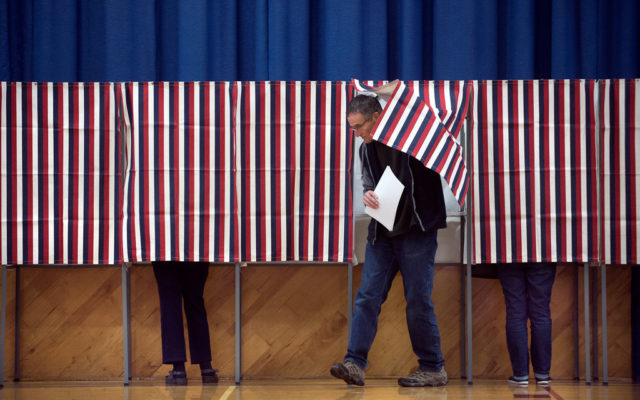
How Mainers can use ranked-choice voting in the 2020 election
It has been a rocky year for Maine’s first-in-the-nation system of ranked-choice voting, but the method has survived court challenges and will be used in the U.S. Senate race and presidential race here in the Nov. 3 election.
Here’s a refresher on how the system can be used, where remaining judicial fights stand and how the votes will be counted after Election Day.
How does ranked-choice voting work?
Ranked-choice voting, passed by Maine voters in a 2016 referendum, differs from traditional elections in which a candidate who gets a plurality of votes wins. In ranked-choice elections, voters choose multiple candidates in order of their preference. A winner is declared if a candidate wins an outright majority of votes.
If no candidate gets more than 50 percent of total votes, the last-place finisher is eliminated. The second choices of voters who cast ballots for that candidate are then considered and reallocated to the remaining candidates. The process repeats until a winner emerges with a majority of the votes in a final round of voting.
How is Maine using ranked-choice voting this year?
This year, the method will mainly apply to two races: the Senate election between Republican Sen. Susan Collins, Maine House Speaker Sara Gideon, D-Freeport, and independents Lisa Savage and Max Linn and the presidential race between Republican incumbent Donald Trump, Democrat Joe Biden, Libertarian Jo Jorgensen, Green Howie Hawkins and Rocky De La Fuente of the Alliance Party.
It is the first time in U.S. history that Electoral College votes will be awarded this way. Maine will effectively run three ranked-choice voting elections to allocate its four electors — two for the statewide winner, one from the 1st Congressional District and one from the 2nd District.
It is worth noting that the ranked-choice ballot design will be used in the elections for Maine’s two seats in the U.S. House of Representatives this year even though there are only two candidates on the ballot in each race. This is because there are certified write-in candidates in each contest. In the highly unlikely scenario that any of them earn enough votes to prevent a majority winner, a ranked-choice count would kick in.
The Maine Constitution bars ranked-choice voting in general elections for state office, so all 2020 legislative races will be decided by pluralities. There are only 10 legislative races out of 186 seats with three candidates facing off.
Do you have to rank every candidate on the ballot for your vote to count?
No. If you rank just one candidate, your vote remains with that candidate throughout the ranked-choice process. Ranking one candidate has the same effect of ranking that same candidate first, second and third, which is also a valid way of voting. The only way your vote is transferred to a second-choice candidate is if your first-choice candidate is eliminated.
However, you may want to rank all candidates in a race because that ensures your ballot will not be “exhausted” — the term for a ballot that does not rank a continuing candidate in a race. If that happens, your vote sticks with your last-ranked candidate who was eliminated and does not move on.
What are mistakes that can be made while ranking choices?
Secretary of State Matt Dunlap’s office has a handy guide to valid and invalid examples of ranked-choice ballots. The biggest thing to avoid is ranking two different candidates first, which is an invalid “overvote” that leads to your vote getting thrown out because it is impossible to determine which candidate you favored.
You also should not skip more than two rankings. If you rank a first choice, then skip rounds two and three while marking a fourth choice, only your first choice will be counted. If you skip the first and second choice to rank a third and fourth choice, your ballot will not be counted.
How are ranked-choice voting results reported?
It can take a while. City and town clerks typically report results to media outlets on election night, but that only includes first-round choices in ranked-choice voting races. If it appears that no candidate in one of those races won an outright majority, ballot information is collected and it goes to Augusta for a ranked-choice count conducted by Dunlap’s office in a process that normally takes a week or so.
The coronavirus pandemic may delay that process further as clerks in some places expect minor delays in counting what is likely to be a record flood of absentee ballots. In most places, that delay is expected to amount to only a day or so.
Could anything change around Maine’s use of ranked-choice voting this year?
It’s unlikely. On Thursday, the Maine Supreme Judicial Court stood by a ruling that allowed ranked-choice voting to move forward in presidential elections after the state Republican Party tried to mount a people’s veto effort to overturn the 2019 law expanding the use of the method.
Republicans have asked the U.S. Supreme Court to delay the Maine court rulings in a move that could put ranked-choice voting on hold for the presidential race, but few cases go to the high court and some Mainers have cast votes. Ballots for overseas and military voters were sent out in mid-September, while absentee ballots were available from local clerks on Friday.
BDN writer Caitlin Andrews contributed to this report.